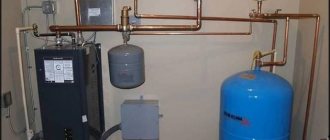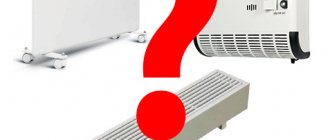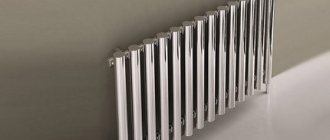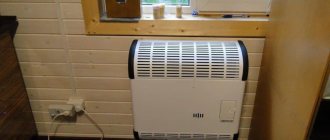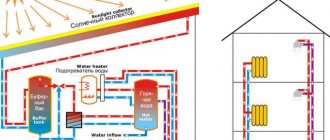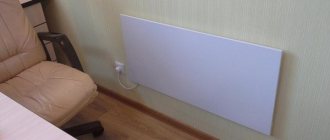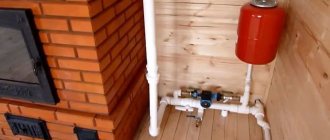The most economical way to heat a private home is a boiler using mains gas. But often, for objective reasons, such an opportunity is not available everywhere. In relative second place in terms of the cost of thermal energy are solid fuel boilers or heating from a fireplace/stove with a closed firebox (if the house is small), but given the need to store fuel and the complexity of maintenance, not everyone likes this heating method. Storing liquefied gas requires expensive containers. Liquid fuel, in addition to difficulties with storage, is characterized by expensive equipment and poor environmental characteristics. Electric heating in a private home does not have all these disadvantages. Except for one thing – the high cost of energy. Although in this case there are opportunities to reduce the burden on the family budget. What features does heating a house with electricity have? We’ll look at the most economical way to heat a house using energy in our article.
Electric heaters do not require chimneys and can be installed anywhere Source poradavam.com
Video description
In our video we’ll talk about heating in a private country house. Our guest is the author and presenter of the Teplo-Voda channel Vladimir Sukhorukov:
Oil radiator
Considered uneconomical - critics argue that it should not be used as a heating device due to high energy consumption and low output. But it is this type of device that has one of the highest efficiency - about 98%. That is, it converts almost all electrical energy into heat (the law of conservation of energy has not yet been canceled), and those minor losses of 2% are due to the resistance of the internal walls of the radiator to the coolant. Yes, it is inertial - it takes a long time to warm up, but it also takes a long time to cool down.
On a note! Accordingly, when using an oil radiator, the room in which it is used will warm up for a long time.
But this is a property of all batteries, including water heating, in which the main method of heat transfer is radiation, which works slowly.
The main disadvantage is the “rough” power control and the use of mechanical thermostats. And such inaccurate control of temperature conditions makes an oil radiator ineffective when trying to optimize the cost of heating with electricity in a private home. And yet, it has a rather high body temperature when operating at full power, which is dangerous if there are small children in the house.
In defense of oil radiators, let’s say that these are still devices for temporary local heating and high energy efficiency has never been required of them.
There are models of oil radiators that can be hung on the wall Source b-sector.ru
Fan heater
It is often written about a fan heater that it burns oxygen. But “oxygen combustion” is nothing more than an oxidation (combustion) process, and the maximum that can burn at a fairly low temperature of the coil is organic dust in the air. Therefore, it is incorrect to talk about burning oxygen (after all, it’s not wood that burns) since this insignificant volume must be replenished as a result of mandatory ventilation of the room.
The efficiency of such a device is slightly lower than that of an oil radiator (part of the electricity is spent on operating the fan), but it is not very different, considering that the power of the fan motor itself is small (about 50 W out of a total of 1 or 2 kW). The advantage is that the room warms up very quickly. Disadvantages are a constant noise level (albeit insignificant) and dust transfer throughout the room. And the main drawback of these household appliances is manual power adjustment and the illusory possibility of creating an automated heating system based on fan heaters
A fan heater is the most compact heating device, and it is great for heating a small area Source romb.ua
Therefore, it is necessary to emphasize once again that the main reason why some types of electric heaters are not suitable for heating a home is not the efficiency (almost all of them are above 95%), but the impossibility of automating system control. It is this factor that does not allow optimizing the operation of the heating system, and without this it is impossible to heat a house with electricity cheaply.
Heating temperature
For an apartment, especially one in which there are small children, it is not recommended to buy heaters whose housings and elements themselves heat up to high temperatures.
For example, oil batteries without a thermostat (or if it suddenly breaks down) can heat up to 120-150 degrees!
It turns out that 2 kW are hidden in a small case, which can only be fully obtained by heating the heater to such temperatures.
At the same time, in order to comply with safety rules and not overheat the surface above 60-70 degrees, temperature sensors are installed. And they, in turn, turn off the heater, which actually never reached its maximum parameters.
And what can we say about the open hot spiral of the fan heater!
Therefore, in this regard, convectors can be considered the safest. When they are ceramic, the body temperature does not exceed 60 degrees. It’s not for nothing that many of them have signs “For kindergartens.”
Among infrared models, micathermic ones stand out in terms of safety.
The heating element in them emits heat, but does not heat up itself.
But for quartz, carbon and halogen filaments, the filaments heat up from 2000 degrees and above, after which infrared radiation actually begins to be produced.
Efficient methods of heating with electricity
Heating with electricity in a private house has the main advantages over all others - these are simple and accurate methods for monitoring and regulating the operation of all components and elements. Even the sensors and display of information about operating modes are more accurate than those of equipment using other types of energy carriers.
When we are talking not just about local heating, but about the heating SYSTEM, this means the following:
- Heating works not only when there is someone in the house (therefore, a wood stove is not a system).
- You can manage the system (set up, regulate), including remotely. Therefore, an oil radiator or fan heater simply plugged into an outlet is not a heating system.
Individual electric heating of a private house has four options for heating systems:
- autonomous water heating systems based on electric boilers:
- use of infrared ceramic heaters;
- electric convectors with electronic thermostats;
- electrical converters with inverter thermostats.
All these systems can be adapted into a smart home system and controlled remotely.
The best inexpensive, economical heaters according to experts, TOP-15
When choosing a heater, it is often difficult to understand just by looking at it in a store whether it is good or not, and testing for functionality is also not enough. Before going to the store, it is important to know exactly which of the heaters will actually cope with its task, and which one should not be considered. For this purpose, we have compiled a rating of the best and inexpensive heaters, suitable for a home, cottage or apartment, for a room of 20 square meters, with a power of 1000 to 2000 W. This rating is based on expert opinion and experience of use by other users. When choosing, also pay additional attention to reviews from other users and the cost in retail stores.
Electric (fan heaters)
Electrolux EFH/S-1115 1500 W (1100 – 4000 RUR)
Zanussi ZFH/C-408 1500 W (1450 – 4000 RUR)
Ballu BFH/C-31 1500 W (790 – 3600 RUR)
Oil radiators
Ballu Classic BOH/CL-09 2000 W (2800 – 3300 RUR)
Electrolux EOH/M-6209 2000 W (3600 – 4900 RUR)
Timberk TOR 21.1507 BC/BCL 1500 W (3400 – 3950 RUR)
Convectors or convection heaters
Ballu Enzo BEC/EZER-1500 1500 W (4230 – 4560 RUR)
Electrolux ECH/AG2-1500 T 1500 W (3580 – 3950 RUR)
Electrolux ECH/AS-1500 ER 1500 W (4500 – 5800 RUR)
Infrared
Ballu BIH-LW-1.5 1500 W (2390 – 2580 RUR)
Almac IK11 1000 W (3650 – 3890 RUR)
Timberk TCH A1N 1000 1000 W (4250 – 4680 RUR)
Infrared micathermic
Polaris PMH 2095 2000 W (RUB 7250 -8560)
Polaris PMH 2007RCD 2000 W (6950 – 8890 RUR)
De'Longhi HMP 1000 1000 W (6590 – 7250 RUR)
Heating with electric boiler
This is a classic diagram of an autonomous heating system. There are two options for heating the coolant - indirect and direct.
Electric boilers of indirect heating come in two types: heating elements and induction.
The design and principle of operation of heating element boilers are quite simple - there is a heating coil enclosed in a sealed metal shell with a dielectric heat-conducting filler, the heat from the spiral through the filler is transferred to the surface of the heating element shell, with which the heating system coolant is in contact.
This is what the “filling” of a 9 kW heating element boiler looks like, which, despite its compact size, is capable of heating a house of 100 m2 Source mirvera.ru
Induction boilers have appeared for domestic heating systems relatively recently. Their operating principle lies in the property of metals to heat up under the influence of an alternating magnetic field. The heating element itself is an inductive coil with a ferromagnetic alloy core, through the “secondary winding” of which the coolant passes.
Scheme of operation of an induction heater Source josri.ru
The peculiarity of direct heating electric boilers is that water not only acts as a coolant, but is also part of the electrical circuit - alternating current passes through it between the electrodes. Hence the name of the boilers - electrode.
Each type of boiler has its own disadvantages. Heating elements form scale, which leads to a decrease in the useful power and service life of the boiler. Induction ones are quite expensive, bulky and have “stepped” power adjustment. Electrode ones have strict restrictions on the quality and composition of water, which must have a certain specific electrical resistance to alternating current.
A cascade of four electrode boilers for heating a large house Source obriy-ua.com
Well, the main disadvantage of heating a country house with an electric boiler is the presence of the coolant itself and the “bulky” circulation system of pipes and radiators. Setting up such a system is costly, and the efficiency compared to direct electric heaters may be lower if circulation pumps are used.
Heater type
Today, the most popular types of heaters are:
- fan heaters
- models operating on the convection principle
- oil
- infrared
Each of them has its own advantages and disadvantages. Here's a summary table for comparison:
Although infrared received the most positive marks, there is no need to rush into making a choice. To choose the right model for yourself, use five rules.
Video description
Video about infrared heaters:
There are three fundamentally different types of infrared heaters:
- reflectors in which the filament coil is enclosed in a quartz glass bulb;
- panel - a heating element is “soldered” in a ceramic monolithic slab;
- film - with carbon coating on a polymer film.
Heating a house with electricity of the first type refers to heaters operating in the short-wave range of infrared radiation.
Such devices can be used as an additional heater, but not as a basic element of the heating system of a private house with electricity.
Disadvantages - the lowest efficiency (due to the visible part of the radiation), lack of precise temperature control and high case temperature.
The second type of device operates in the soft long-wave range. The maximum temperature of the ceramic panel does not exceed 90°C, but on the body it is even lower. There are two types of control - mechanical and electronic thermostat. The first option involves manual control and its accuracy is low. Using electronic thermostats, you can set the temperature with an accuracy of 1°C.
The infrared panel is so safe that it can be hung on wooden walls Source centr-tepla.in.ua
The peculiarity of film heaters is that they heat not the air, but the objects in the radiation zone (and the objects then the air). Therefore, it is not practical to use them at home as the main heating system. Knowing this property of heating films, you can use them in the right place - where a person is located directly at this time, on open verandas, garages. I turned it on, and it was immediately warm; when I left, I turned it off, so as not to heat up the street or the garage where no one was there.
Installing films in the bedroom is uncomfortable: if you are in the zone of action of the heater, it will be hot, if not in the zone, then it will be cold. The best option is to use them as part of a heated floor - this is most comfortable for a person when his feet are warm and his head is cool. Operation is controlled automatically using a temperature sensor-thermostat pair.
If there is not enough space on the floor, then the film heater can be mounted on any free plane Source otdelka-expert.ru
How to choose a heater: we help you decide on the criteria
A household heater for an apartment or country house, as a rule, is a fairly simple device. Of course, sometimes you can find high-tech heaters with remote control from a smartphone, but in most cases there is nothing complicated in such devices.
Accordingly, choosing a suitable heater will not be too difficult. The main thing is to decide on the basic parameters. First of all, this is the type of heater and its power, and secondly, additional features and options.
Heater type
There are several differently designed heaters on the modern market, which differ not only in type, but also in their qualities - some of them are better suited for a city apartment, others for a country house, and others for heating technical premises. Let's figure out what types of heaters there are and how they differ.
On store shelves you can find oil radiators, fan heaters, heat guns, convectors, infrared heaters, infrared film, infrared convective heaters and thermal curtains. Let's look at them, starting with the simplest models.
Oil radiators
An oil radiator is familiar to everyone: this is the type of heater that can most often be found in a country house (especially if it was built more than twenty years ago). The oil radiator is a sealed metal housing, inside of which a special mineral oil is filled. The heating element (electric coil) is also located inside the housing. Thus, the spiral heats the oil, the oil heats the body, and the heater body heats the surrounding air.
Oil radiator Sencor soh-2107bk is a typical representative of its class
Visually, an oil radiator is similar to a central heating battery: it often has similar compartments. As a rule, such a heater does not have a fan.
Like a central heating radiator, an oil radiator is best suited for use in areas where constant air heating is required. It takes a long time to warm up and does not immediately begin heating the air. On the other hand, the temperature of the radiator itself is not so high as to burn dust particles that fall on it (and therefore, there will be no foreign smell in the room). Oil heaters operate almost silently, retain heat for a long time after being turned off and are considered environmentally friendly. Among the minuses, it is worth noting their rather large size and low mobility (even despite the presence of special wheeled legs).
It’s easy to imagine that if you take two heaters of equal power, the more compact one will have a higher temperature. Therefore, it is better to choose a larger model (if space allows), which will reduce the likelihood of accidental burns.
Fan heaters
A fan heater is a combination of a heating element (we'll talk about their types later) and a fan that circulates air in the room. Many of these devices can work as a regular fan, but they cannot heat the air with the fan turned off - accordingly, there are no silent fan heaters. However, we would not seriously recommend using such a device in the “without heating” mode as a regular fan: they usually blow rather weakly, and in order to create the effect of a “cooling breeze”, you will have to place it directly opposite you at a distance of no more than a meter.
Fan heater Ballu BFH/S-04 - small and compact
The main task of a fan heater is to quickly heat the air in a cold room. Indeed, the effect of such a heater becomes noticeable in just a few minutes. Well, if you need to heat a construction site or a large room, then a heat gun is suitable for solving this problem - essentially the same heat fan, characterized by increased power and the ability to operate for a long time without pauses. The “payback” for fast and powerful heating will be a high noise level and corresponding electricity consumption: many owners of country houses, especially those built quite a long time ago, are faced with the fact that it is not possible to heat more than two rooms with fan heaters, since they are simply “eat up” all the power supplied to the house.
Also, do not forget that heat guns come in very high power - for example, 5 kW, and even more. Not every outlet and not every wiring can withstand such energy consumption.
Heat guns of the Prorab series clearly hint at use during repairs
Many expensive fan heaters have a built-in motor, which ensures rotation of the device in a horizontal plane and, as a result, improved air circulation and more uniform heating of the room.
Also worth mentioning are the so-called “ceramic” fan heaters - their metal spiral is not blown directly with air, but serves to heat the ceramic heating element, which, in turn, heats the air. Ceramic fan heaters are practically free of the main drawback of a conventional fan heater - the characteristic smell of “burnt dust”, which arises from the combustion of dust particles falling directly on the hot wire.
Convectors
A convection heater works in a similar way. The difference from a fan heater here is the absence of a fan itself: the air in a convector heater passes through the heating element, after which it naturally rises, making room for colder layers of air that rise from the floor. As a result, the size of the heating element of such a heater will be significantly larger (in terms of dimensions it can be compared with a “flat” central heating battery).
Convector heater Optima CH-1600Y/W with temperature control and wall mounting option
Convector heaters are suitable for wall mounting and usually look quite stylish. True, they do not heat the air as quickly as heat fans.
Note that convectors are ideal for combining into a single network, which allows centralized control of the heating of one or several rooms.
Infrared heaters
Infrared heaters are designed in a fundamentally different way: they heat not the air, but the surrounding objects (primarily the floor or walls) using infrared radiation. The air in the room is already heated by them. The heating element of such heaters are quartz tubes or lamps.
Glass infrared heater Peony Thermo Glass from a domestic manufacturer
Infrared heaters operate silently and can be used where heating of surrounding objects rather than air is required - for example, outdoors (for heating gazebos and verandas). They are also often used in bathrooms. They are also ideal for working in rooms where it is necessary to maintain a certain low temperature, and it seems impractical to heat the entire volume of air. But for heating rooms where there are many rooms and/or partitions, they are not very suitable: infrared rays will not be able to go around multiple obstacles.
It should be mentioned that since IR radiation heats the objects it hits, one of these objects is a person in the room. Therefore, the “feeling of warmth” from the IR heater appears almost immediately after it is turned on. However, there are a few things to consider here:
- the sensation has appeared - but the ambient temperature has not yet changed;
- heat only to those parts of the body that are exposed to radiation;
- Depending on the distance to the IR heater, you can either feel the heat or not feel anything at all.
It is worth highlighting such types of infrared heaters as “infrared-convective” and “infrared film”. The first of them combine the advantages of convective and infrared models. Heating is provided both by a heating element located inside the heater and by heat transfer from the front surface of the heater. According to the developers, this “combined” heating method allows you to create a comfortable microclimate in the room without unnecessary energy costs.
UFO wall-mounted film heater disguised as a painting
As for infrared film heaters, they are a thin heating element made of film and foil. Such heaters are often made in the form of rugs or wall paintings (the design of such paintings, however, is questionable). They were also used as “warm floors”. The power of infrared film heaters usually does not exceed 400-500 W.
Thermal curtains
Thermal curtains are a separate category of devices that also act as a heater. Thermal curtains are installed in door (or window) openings and create a flow of warm air that blocks drafts. Thermal curtains are usually used in rooms where doors are often opened (for example, in offices), or where there is a danger of drafts and an additional warm zone needs to be created.
Electric thermal curtain Daire HT 508 with power up to 5 kW
They can also cope with heating small rooms, but a thermal curtain cannot cope with complex heating tasks. It is worth noting that the power of the thermal curtain must be selected in accordance with the size of the door or window on which it will be installed.
Efficiency and performance
For each heater, the manufacturer indicates the comfortable and maximum area of the room for which a particular device is intended. Thanks to these parameters, it is easiest to understand what power device you will need. In most cases, the dependence here will turn out to be strictly linear: if the heater’s power is twice as high, then it will produce approximately twice as much heat per unit time.
The type of heater in this case does not matter: if two heaters spent the same amount of energy, then they heated the room equally (but not necessarily in the same time!).
Control and display
Simple heaters have a mechanical control system, which looks like a set of temperature-regulating knobs and on/off buttons. Such heaters can operate in full or partial load mode and switch off on their own when a certain temperature is reached, but, as a rule, they are not capable of more.
It should also be taken into account that the temperature control will be quite rough, and, as a rule, not in degrees, but in the form of a rotating knob with the values “minimum”, “maximum” and several intermediate nameless gradations. Thus, you will be faced with a rather long procedure for selecting the optimal position of this knob in accordance with your own feelings about the temperature in the room.
Mechanical heater control system
Modern models are increasingly equipped with an electronic control system, including a set of mechanical or touch buttons and a digital display. The capabilities of such heaters are much wider: they can turn on and off according to a schedule, maintain a set temperature (in degrees) in the room, display the temperature and current time on the display, and much more. Such heaters often come with a remote control.
Electronic control system with temperature indication
Finally, the most “advanced” heaters have the ability to be remotely controlled. Such devices have a built-in Wi-Fi or Bluetooth transmitter, so you can control the device from your smartphone using a special application.
Features and functions
Depending on the complexity, the heater may have a different set of capabilities and functions. The simplest heaters (for example, many oil heaters) heat up to a certain temperature, after which they turn off for a while. More advanced devices are able to control the temperature in the room and turn on and off depending on environmental conditions.
Heaters with an electronic control system can be equipped with a delayed start and end time, turn on and off according to a schedule, and often have a set of programs for various use scenarios.
Heaters with remote control via Bluetooth or Wi-Fi allow the user to control their operation remotely. Thanks to this solution, the heater can be turned on or off remotely. For example, it will be useful to turn on the heater before going to the countryside so that you arrive at a house that has already been warmed up.
Noise level
For most heaters, the documentation indicates the maximum noise level. You need to look at this parameter if the heater is installed in the bedroom, in the nursery or in the study - in general, where silence is required. The quietest heaters are infrared. They are followed by oil heaters, convector type heaters, and then fan heaters and heat guns.
It is worth considering that sometimes noise can be made by a temperature relay or a speaker that notifies the user of a change in operating mode (or is triggered when buttons are pressed). Since such sounds can be quite annoying, it is better to make sure in advance that there are no such effects. By the way, it doesn’t hurt to check the brightness of the display so that it doesn’t suddenly turn out that the heater that is supposed to be installed in the bedroom is shining too brightly.
Protection
Almost all heaters have a safety system that turns them off if they overheat. A built-in fuse or overheat sensor located at the air outlet will avoid fire and unnecessary load on the electrical network.
Many heaters also have a system that turns off the unit if it is dropped. Provided that safety precautions are observed (the heater is installed correctly and is not covered with rags or foreign objects), such systems guarantee that the device will not cause a fire.
However, you can still get burned on many heaters. Therefore, if there are children and elderly people in the house, it is better to think about buying the safest possible heater that will be difficult to snag or drop (such as wall heaters).
If the heater is intended to be installed in the bathroom, you should pay attention to models with a waterproof housing. This will allow you not to worry about water getting into the device body and a possible short circuit. Using a heater in the bathroom will not only achieve a comfortable temperature, but also prevent the appearance of fungus on the walls.
Installation type
Different heaters allow different installation methods. Many of them are simply placed on the floor (oil heaters) and have special wheels for moving. Others allow installation on any flat surface, such as a table or window sill (many fan heaters include these). Such heaters do not require special installation efforts. At the most, the user will have to assemble the legs with wheels themselves.
Also, many heaters have several installation options for the user to choose from: wall, floor, ceiling or suspended ceiling. Moreover, the same model can allow several installation options at once (for example, wall or ceiling). In this case, the installation will require a drill or hammer drill and other related tools with which to install the fasteners.
Let's sum it up
Household electric heaters come in four main types:
- oil radiator
- fan heater or heat gun
- convector
- infrared heater
The main distinctive properties of the heater, critical for the user, are:
- room heating rate
- noisiness
- mobility, i.e. ease of moving the heater from place to place
- negative impact on the air
A table in which we have evaluated each parameter for each type of heater will help you make your final choice.
| Room heating speed | Noisiness | Mobility | Air exposure | |
| Oil radiator | low | low | average | No |
| Fan heater | high | high | high | smell of "burnt dust" |
| Heat gun | very high | very high | high | smell of "burnt dust" |
| Ceramic fan heater | average | high | high | almost odorless |
| Convector | low | silent | average | No |
| Infrared heater | low | silent | low | No |
Convectors
A convector is a metal body of a certain design with an inlet and outlet to create the effect of air convection. There is a heating element inside the convector. Heating elements come in several types (in order of technical evolution): needle-shaped with filaments, heating elements, X-shaped monoliths, and monoliths with “scales” - Hedgehog. The inlet channel is closed with various types of filters to protect against dust, the outlet - with a decorative grille to protect against the ingress of small objects and more uniform distribution of heated air.
The convector body not only serves as protection for the heating element, but also increases the speed of the upward flow. Due to this, with the same power, the room is heated faster than from a water heating battery.
The stylish convector panel looks great in a modern interior Source teplo-vsem.ru
Convectors have three types of thermostats - mechanical, electronic and, more recently, inverter.
A mechanical and electronic thermostat is a thermal relay that turns the convector on and off depending on the temperature set on it. In a mechanical thermostat, the temperature is set by a manual regulator, often “by eye”; in an electronic thermostat, by touch buttons with a digital indication of the temperature value.
The inverter thermostat (control unit), unlike the mechanical and electronic thermostat, which operate in on/off mode, controls the operation of the convector according to a different principle - with automatic change of heating power, which allows achieving high energy efficiency indicators. Such savings can reach 40-70% of electricity compared to the usual on/off convector.
The reason for this saving is in such a thing as hysteresis: this is the temperature difference at which the thermostat turns the device on and off. Convectors with a mechanical or electronic thermostat turn on and off not when the set temperature is reached exactly, but with an error predetermined by the manufacturer. This is done so that the heater does not turn on and off at a high frequency (the lower the hysteresis, the higher this frequency). In this case, the automation would quickly fail. Therefore, such convectors always have a difference of several degrees between turning on and off, no matter how accurately they measure the temperature. And these extra degrees on/off of convectors consume extra electricity.
A convector with an inverter thermostat operates according to a different algorithm: it does not have parameters such as the temperature at which the heater turns on and off. The inverter thermostat does not turn off/turn on the heating, but automatically reduces/increases the heating power depending on the temperature difference and the rate of change of this temperature.
Body pumps
We should also talk about heat pumps. Although this system is not purely electrical, it does require this energy resource to function. All of the electric heating systems discussed above for residential buildings and apartments convert electricity directly into heat, so their efficiency is approximately equal. Most electric heaters convert almost 100% of electricity into heat. The difference between different types is insignificant. But heat pumps are fundamentally different for the better from other electric heating systems. This is due to the fact that they do not convert electricity, but use it to deliver heat from the atmosphere or ground to the heated room.
They work on the principle of an air conditioner, that is, they mainly consist of a compressor that runs on freon. With its use, heat from the outside air or soil is pumped into a coolant, which then delivers it to the serviced premises.
The efficiency of a heat pump is several times higher than that of conventional electric heaters. Depending on the temperature, up to 5 or more kilowatts of heat can be created for every kilowatt of electricity.
An example of a real system with an intelligent control circuit for electric heating at home
NOBO, a leading European manufacturer of convectors, produces two compatible systems for “smart” control of electrical appliances. Including “warm floors” (via a thermostat) and any other household appliances that are connected to the network (via a panel, a “break” in the circuit or turning on/off sockets). To do this, they produce special thermostats, socket receivers and hidden-mounted relay receivers.
Using such a system, you can monitor and manage the operation of up to 100 devices or group zones. And thermostats of the 700 series provide 4 operating modes for convectors: comfortable, economical, non-freezing (air temperature 7°C) and “off”. According to the manufacturer, the flexibility of such a control system for convectors and heated floors allows you to save up to 25% on electric heating at home.
One of two control schemes for a multi-zone electrical system Source stroydoma74.ru
Infrared heaters
Most people are still wary of infrared models. Their operating principle is somewhat similar to the sun.
The infrared radiation of the lamps does not heat the air in the room, but the objects located in it, which then give off heat to the surrounding space. Heating occurs due to invisible rays in the infrared spectrum.
You need to get used to this. The feeling under the heater itself will be as if you were sitting near a stove. One side is fried and the other is at room temperature.
To protect yourself from the effects of such equipment, follow basic rules of use.
If you stay under such a heater for a very long time, you may feel a headache and fatigue.
However, the same thing happens from prolonged exposure to the sun or when sitting for a long time near an open fire.
In addition, the infrared spectrum in excess quantities can negatively affect the skin. Such a beam is capable of penetrating to a depth of several centimeters under the skin and only then releasing heat from the inside, heading to the outer surface of the skin.
Everything here depends on the power of the source and the duration of stay under it. If you follow the instructions, then you should not be afraid of such radiation. How to protect yourself?
The most important thing is to maintain a minimum distance from the infrared heater. It must be at least 2 meters.
The advantages of infrared technology include:
- instant warmth
- almost complete absence of oxygen loss
- no odor
- noiselessness
And as numerous tests show, such heating is the most fireproof. Even if you place a Christmas tree directly under an infrared heater (right up to its touching the protective screen), setting it on fire will be problematic.
Just don’t try to purposefully repeat such experiments at home. Heater is different from heater, and compliance with safety regulations should come first.
The device is lightweight. It can be equally successfully placed on the walls or ceiling (hung on mounting chains like a fluorescent lamp).
So fix it on special legs.
However, there are also some peculiarities. One of the disadvantages is that the efficiency of the device is limited by the dispersion angle.
Step outside this zone and you will immediately feel a temperature difference of several degrees. From the very beginning, IR heaters were created specifically for heating only work areas in rooms without heating.
To improve the heating efficiency when suspended from the ceiling, you can paint the floors a dark color.
There are also models made from ceramic plates, which also emit infrared thermal radiation, plus they look beautiful.
They have low power and are resistant to moisture. Therefore, they can be safely used in the bathroom.
Similar models of infrared heaters can be installed in children's rooms, on balconies and even outside in gazebos.
Fan heater
In fan heaters, air is heated using a hot electric coil and a fan that drives air through it.
The room gets warm quite quickly, but when you turn it off it also gets cold quickly.
Since the coil is very hot, this type of heater dries out the air and burns house dust.
As a result, specific odors appear. Therefore, in recent years, models with a ceramic heating element that are free of these disadvantages have become widespread.
In addition, the fan heater makes quite a noticeable noise during operation. So you won't get much sleep at night with him.
But its obvious advantages are its compact size and low cost.

